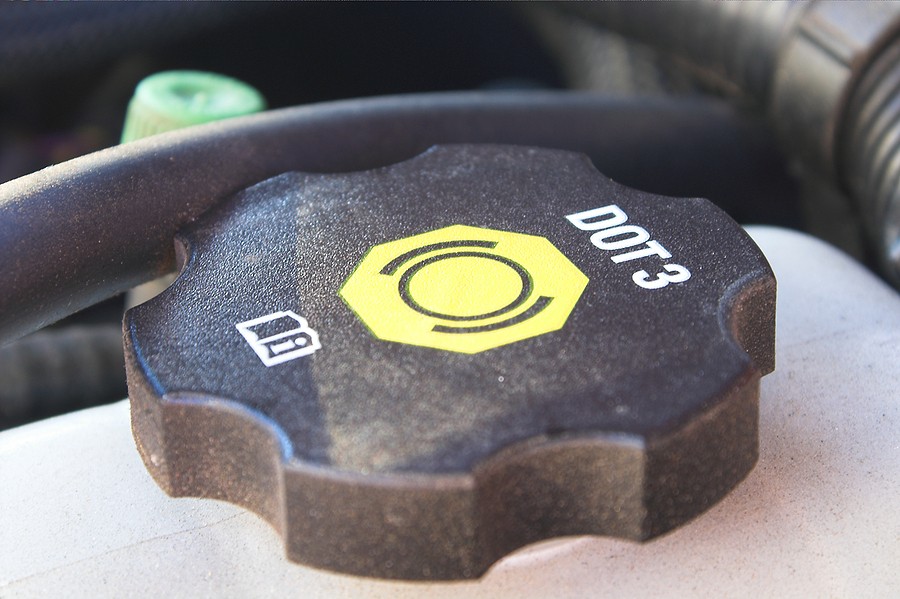Getting your brake fluid flush this would have been more overlooked parts of his routine car maintenance. Things like transmission fluid and motor oil are what we generally think of when we are considering the fluids that need to be replaced in a vehicle. However, your brake fluid does need to be maintained and if it goes bad there could be some severe consequences as a result. A brake fluid flush is typically going to cost you somewhere between $80 and $200.
The exact cost of a brake fluid flush really depends on the make and model of the vehicle you're driving as well as where you take it to get it done. Dealerships typically charge more for those kinds of repairs than a mechanic does, and of course you have the option of doing it at home if you're comfortable with DIY car repairs.
Can you eat brake fluid flush done in a more standard kind of car like a Toyota Camry will likely be cheaper than if you have a higher end vehicle like an Audi A4 or something exotic like a Bentley Mulsanne. Those are just a few of the factors that you should keep in mind before heading out to get your fluid flushed if it needs to be done.
Is a Brake Fluid Flush Really Necessary?
Your brakes work as part of a hydraulic system in your car. When you put your foot on the brake a plunger is forced against a master cylinder and that causes brake fluid to push through the hoses to the brakes on each wheel of your car. If you have disc brakes that fluid is forced into a calibre which presses against a piston and squeezes the brake pads against the disc in the wheel of your car. The process is similar to drum brakes where the fluid is forced into the cylinder and pushes the brake shoe against the drum. Either way, both use friction to stop your car's wheels from spinning and the pressure that allows this to happen is provided by the brake fluid in the lines.
Most drivers don't consider that over time this brake fluid can wear down and become contaminated. Rust and other debris will build up in the line which limits the effectiveness of the brake fluid in the hydraulic power in the system. As well, brake fluid is hygroscopic which means that it absorbs water. This really can't be avoided and it's going to take on a small percentage of its own wage in water every single year. That's why brake fluid flushes are essential eventually because the more water in the line, the less effective the brake fluid will be.
A brake fluid flushes necessary if you want to maintain your brakes over the long-term. If you avoid it, eventually you're going to be faced with brake failure and a larger, more complicated repair job with a freighter cost in the long run. It may not happen right away, but it can be prevented entirely with some routine maintenance.
How Often Should You Replace Brake Fluid?
Every vehicle manufacturer has a recommended schedule of maintenance for every model they produce. There's no hard-and-fast rule about exactly when you should flush your brake fluid but on average it's recommended around every 30,000 miles or so. If you want to know for sure, you can check your owner's manual or Google the make and model of your car.
Chevy, for example, recommends a brake fluid flush every 45,000 miles or so. Mercedes however recommends 20,000 miles. So, there's quite a big range depending on what kind of car you're driving that you need to keep in mind.
It’s also worth remembering that break flushing and brake bleeding are not the same thing so you shouldn't confuse the two. When you get your brakes flushed it removes all of the old brake fluid in the system and replaces it with new liquid. However, when you get your brakes bled it's just removing a small amount of fluid to flush air from the brake lines. The fluid itself is not being replaced, so you're not removing any contaminants or extending the life of your brakes considerably. All things being equal, you'll do yourself more good to get your brakes flushed rather than bled.
What Happens if You Don't Flush Brake Fluid?
As we said, your brake fluid will become contaminated over time with dirt and rubber and rust as well as moisture in the lines. If you don't get your brake fluid flushed this contamination will continue and, in particular, the water inside can cause corrosion in the brake lines, calipers, and other parts. This can end up degrading your entire braking system and causing it to fail on you. You'll need to not just replace the fluid, but you could end up having to replace all of those parts as well if they've become badly corroded. These parts and the repair bills can end up costing you many hundreds of dollars and upwards of $1,000 or more depending on how severe the problem gets.
Most importantly however is the fact that not getting your brake lines flushed means that you're potentially sacrificing the effectiveness of your brakes. Your brakes will become less responsive, meaning that it may take longer for you to come to a stop. Or you may not be able to stop properly at all. This is obviously a massive safety concern and something that you never want to take any chances with.
How Do You Know When Brake Fluid is Bad?
There are a few signs that you could be on the lookout for to let you know that you have a problem with your brake fluid and that it's going to need to be changed soon. If you are experiencing any of these then there's a good chance that your brake fluid isn’t doing the job it is supposed to be doing and you should get it changed as soon as you can. You don't want to risk keeping bad brake fluid for too long thanks to the danger that it represents to you and other drivers on the road when your brakes aren't functioning properly.
Dirty Brake Fluid
If you check out the brake fluid reservoir under the hood of your car you may notice that the colour has gone off slightly. Clean, new brake fluid should be clear or at the most have a very slight gold colour to it like very pale honey. When the fluid in your reservoir is visibly darker than that, it has become a rich honey shade or even turns brown or black then you know it's become contaminated. This could happen either because it's been far too long since it's been changed, or you have an excessive amount of contamination from rust, rubber, and debris getting clogged in the line.
Veering When Stopping
It's possible that when you are coming to a stop and you find your car pulling in one direction or another that your brake fluid is to blame. This is because if you have low brake fluid, it's not able to work evenly between all the wheels in your vehicle. This can cause the brakes to work more poorly on one wheel than another and the response will be on even causing you to veer in one direction or another.
Soft Brake Pedals
It's hard to describe this feeling exactly but if you have experienced it, you know it. When you put your foot on the brakes and it feels soft almost like a sponge, not that it is resisting you but that you're just pushing it into something soft, that's a sign you have a problem with your brake fluid. This could be because you have an excess of moisture in the brake fluid which, when exposed to the heat and pressure that your brake lines are under, begins to boil and create air pockets. These air pockets squish down in the lines and reduce the effectiveness of the whole hydraulic system. That means you'll be pressing the brake pedal not getting the response here expecting. In turn, that means your brakes will not be working the way they're supposed to, and you won't be able to stop when and how you're used to.
Low Fluid Levels
When you're inspecting the fluid reservoir for your brake fluid even if it's not discolored, you might notice that the levels are low. Typically, the warning light will come up on your dash to let you know about this. If the fluid levels are low, then you likely have a leak somewhere in your system. Over time, you'll get more fluid leaking out and the results will be the failure of your brakes. This is obviously extremely dangerous and needs to be repaired right away.
You may notice some spots on the driveway that can help you identify this problem. Unfortunately, as we said, brake fluid is usually clear, and the leak probably will not be severe enough that you'll have giant puddles. There may only be a few spots of fluid present but if you do notice it, then definitely get it checked in.
Check Engine Light
Depending on the make and model of your vehicle you may either get a check engine light or an ABS warning light. The ABS warning light at least lets you know that it's a problem with your anti-lock brakes that you have to look into. The check engine light is quite a bit vaguer unfortunately, so you'll have to do a bit of digging to get to the root of the problem. Oftentimes you'll experience more than one of these symptoms at the same time to help you realize that it's the brakes that you're having an issue with.
When a check engine light pops up on your vehicle and you're not sure exactly what it's referring to, since there are literally hundreds of reasons that this can happen, you may want to use an OBD2 scanner to figure it out. An on-board diagnostic scanner is what a mechanical used to diagnose these warning lights when they pop up on your dashboard. It will give you an error code to let you know what's gone wrong with your vehicle so that you can narrow your focus on where the problem is. While the kind your mechanic uses is probably very expensive, you can get your own at a relatively low price. Amazon.com has several options that cost between $30 and $40. If you're interested in doing any kind of home auto repair, this is a good diagnostic tool to have in your toolbox.
Can I Flush My Own Brake Fluid?
It's not impossible to do your own DIY brake fluid flush but it's also not something that the average person is probably going to be able to do. A brake fluid flush is a fairly in-depth procedure that requires a lot of skill to pull off. It also requires some specialized equipment including a pressurized pump that will force the old fluid out of the lines. For these reasons, it's generally recommended that you do take your car into someone who specializes in brakes to get it done. You need to be able to raise up your car, remove the wheels, and flush all of the fluid. It is just not practical for the average driver.
At home, you may be able to do a fluid swap but that's different from a fluid flush. A fluid swap just involves a simple drain of the fluid and then pouring new brake fluid in. It doesn't clean the lines out however and most of the contamination in the lines will likely stay if that's a problem. Consider this a Band-Aid solution rather than a fix.
The Bottom Line
Brake fluid is absolutely important to the proper functioning of the brakes in your car. This is a safety feature that helps not just you but everyone else on the road. While you can take chances with some parts of your vehicle in terms of maintenance and upkeep, you never want to slack off when it comes to keeping your brakes in peak working condition. The moment you notice you have an issue with your brake fluid you need to get it looked at as soon as possible to keep your car safe.



